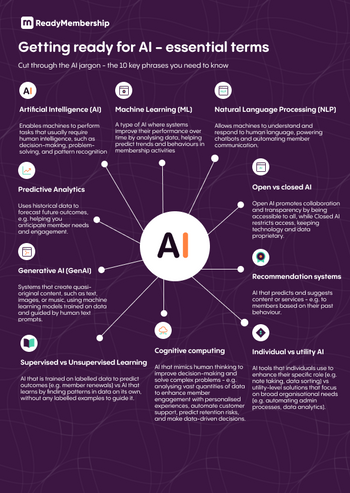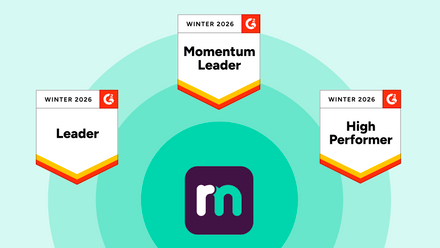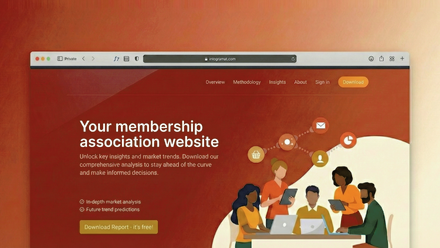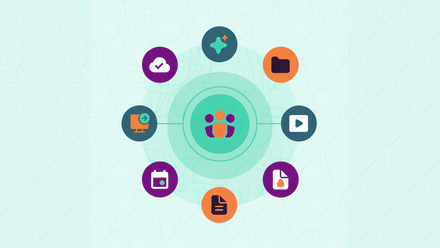AI: 10 Essential Terms Membership Professionals Should Know
1. Artificial Intelligence (AI)
At its core, AI refers to the capability of machines to perform tasks that typically require human intelligence, such as decision-making, problem-solving, and pattern recognition. For membership professionals, AI can automate routine tasks like data entry, analyse member data to identify trends, and even predict future behaviours, freeing up time to focus on building stronger relationships with your members.
2. Machine Learning (ML)
Machine Learning is a subset of AI that’s all about learning from data. Rather than being explicitly programmed to perform a task, a machine learning algorithm gets better at a task over time by analysing data. For example, ML algorithms can be used to predict which members are less likely to renew, allowing your team to take proactive steps to retain them. It’s also helpful for segmenting members based on behaviours or preferences, enabling more targeted communication.
3. Natural Language Processing (NLP)
Natural Language Processing might sound like something out of a science fiction novel, but it’s very much a part of today’s technology landscape. NLP is the field of AI that enables machines to understand and interact with human language. Think of it as the technology behind chatbots and virtual assistants. NLP can also analyse member feedback, help personalise communications at scale, and enhance overall member engagement by providing timely, relevant information.
4. Cognitive Computing
Unlike general AI, cognitive computing mimics human thought processes to improve decision-making and solve complex problems. In membership organisations, cognitive computing can analyse large data sets to provide personalised member experiences, predict retention risks, and make data-driven strategic decisions. Think of it as AI that thinks like you, but faster.
5. Generative AI (GenAI)
Generative AI systems create quasi-new content—such as text, images, or music—based on patterns learned from existing data. For example, you might use GenAI to produce personalised content or marketing materials for different member segments, guided by human input.
6. Predictive Analytics
Wouldn’t it be great if you could see into the future? While we’re not quite there yet, Predictive Analytics comes close. This technology uses historical data to predict future outcomes. For membership, this could mean forecasting member engagement, predicting which services or events will be popular, or even identifying members who might need a little extra attention to stay engaged.
7. Open AI vs closed AI
Open AI promotes collaboration and transparency by being accessible to all, allowing a broader range of developers and organisations to contribute and innovate. In contrast, Closed AI systems are proprietary, developed, and controlled by specific organisations, often using unique, first-party data for more tailored results. Understanding the difference is important when deciding which type aligns best with your organisation's goals.
8. Individual AI vs. utility AI
Individual AI refers to tools such as ChatGPT, Fathom, Jasper AI that are used by individuals to enhance specific roles by streamlining tasks such as note-taking, image generation, data sorting, tailoring communication, content curation, and production of member strategies. Utility-level solutions focus on broader organisational needs, such as automating administrative processes & personalised member communications, and data analytics for strategic insights.
9. Recommendation Systems
AI-driven recommendation systems predict and suggest relevant content or services to members based on their past behaviour. For example, you could recommend specific events, resources, or content to members who have shown interest in similar topics, thereby increasing engagement and value.
10. Supervised vs. Unsupervised Learning
Supervised learning involves training AI on labelled data to predict specific outcomes, like member renewals. In contrast, unsupervised learning helps AI find patterns in data without predefined labels, potentially uncovering new insights about member behaviour and preferences.
Finally, as we embrace AI, it’s crucial to consider Ethics in AI. This involves ensuring that AI is used responsibly, avoiding biases in decision-making, and respecting member privacy. For instance, when using AI to personalise communications, it's important to be transparent with your members about how their data is being used and to ensure their information is protected. Independent bodies researching ethics in AI include the Alan Turing Institute, the AI Now Institute, the Ada Lovelace Institute and the UK government’s AI Safety Institute to name a few.
Bringing It All Together
AI has the potential to revolutionise how membership organisations operate, offering tools that can enhance efficiency, personalise member experiences, and provide deeper insights into member behaviour.
Remember, the goal of AI isn’t to replace the human touch that’s so vital in membership organisations. Rather, it’s about augmenting your capabilities, freeing you from routine tasks so you can spend more time on what truly matters: fostering meaningful connections with your members.
Get Ready for AI: download your free infographic!
To make things easier, we've summarised these essential AI terms and concepts in a handy infographic - perfect for a quick reference or to share with your team. Download it now and stay ahead in the ever-evolving world of AI. Click the infographic below to open full size and download it to your desktop.







